
Sagitta is a dim but distinctive constellation in the northern sky. Its name is Latin for 'arrow', not to be confused with the significantly larger constellation Sagittarius 'the archer'. It was included among the 48 constellations listed by the 2nd-century astronomer Ptolemy, and it remains one of the 88 modern constellations defined by the International Astronomical Union. Although it dates to antiquity, Sagitta has no star brighter than 3rd magnitude and has the third-smallest area of any constellation.

A planetary nebula is a type of emission nebula consisting of an expanding, glowing shell of ionized gas ejected from red giant stars late in their lives.

A proplyd, short for ionized protoplanetary disk, is an externally illuminated photoevaporating protoplanetary disk around a young star. Nearly 180 proplyds have been discovered in the Orion Nebula. Images of proplyds in other star-forming regions are rare, while Orion is the only region with a large known sample due to its relative proximity to Earth.
Photoevaporation denotes the process where energetic radiation ionises gas and causes it to disperse away from the ionising source. This typically refers to an astrophysical context where ultraviolet radiation from hot stars acts on clouds of material such as molecular clouds, protoplanetary disks, or planetary atmospheres.

The asymptotic giant branch (AGB) is a region of the Hertzsprung–Russell diagram populated by evolved cool luminous stars. This is a period of stellar evolution undertaken by all low- to intermediate-mass stars (about 0.5 to 8 solar masses) late in their lives.

LBV 1806−20 is a candidate luminous blue variable (LBV) and likely binary star located around 28,000 light-years (8,700 pc) from the Sun, towards the center of the Milky Way. It has an estimated mass of around 36 solar masses and an estimated variable luminosity of around two million times that of the Sun. It is highly luminous but is invisible from the Solar System at visual wavelengths because less than one billionth of its visible light reaches us.

Xi Aquilae, officially named Libertas, is a red-clump giant star located at a distance of 184 light-years from the Sun in the equatorial constellation of Aquila. As of 2008, an extrasolar planet has been confirmed in orbit around the star.
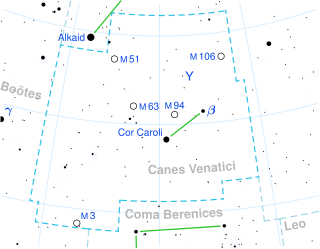
La Superba is a strikingly red giant star in the constellation Canes Venatici. It is a carbon star and semiregular variable.
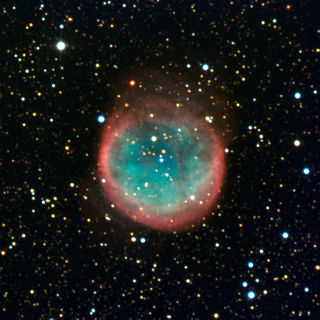
NGC 6781 is a planetary nebula located in the equatorial constellation of Aquila, about 2.5° east-northeast of the 5th magnitude star 19 Aquilae. It was discovered July 30, 1788 by the Anglo-German astronomer William Herschel. The nebula lies at a distance of 1,500 ly from the Sun. It has a visual magnitude of 11.4 and spans an angular size of 1.9 × 1.8 arcminutes.

The Quintuplet cluster is a dense cluster of massive young stars about 100 light years from the Galactic Center (GC). Its name comes from the fact it has five prominent infrared sources residing in it. Along with the Arches Cluster it is one of two in the immediate GC region. Due to heavy extinction by dust in the vicinity, it is invisible to optical observation and must be studied in the X-ray, radio, and infrared bands.
FG Sagittae is a supergiant star in the constellation Sagitta at a distance of 4000 light-years. When first noted in 1943, it was identified to be a variable star, and it was found to be a hot, blue star of stellar spectral type B in 1955. Since then it has expanded and cooled, becoming a yellow G-type star by 1991, and then further cooling to become an orange K-type star. It started to pulsate when becoming an A-type star with a period of 15 days. This period later increased to over 100 days.
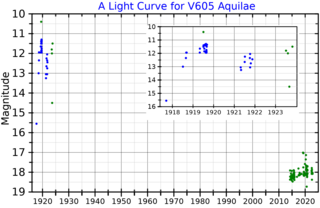
V605 Aquilae, in the constellation Aquila, is the variable central star of the planetary nebula Abell 58. It is a highly unusual hydrogen-deficient carbon-rich star.

Beta Sagittae, Latinized from β Sagittae, is a single star in the northern constellation of Sagitta. It is a faint star but visible to the naked eye with an apparent visual magnitude of 4.38. Based upon an annual parallax shift of 7.7237 mas as seen from the Gaia satellite, it is located 420 light years from the Sun. The star is moving closer to the Sun with a radial velocity of −22 km/s.

IRC+10420, also known as V1302 Aql, is a yellow hypergiant star located in the constellation of Aquila at a distance of 4-6 kiloparsecs of the Sun.

HD 179821 or V1427 Aquilae is either a post-red supergiant yellow hypergiant or a post-AGB yellow supergiant star in the constellation of Aquila, surrounded by a detached dust shell. It is a semi-regular variable nearing the end of its life.

CK Vulpeculae is an object whose exact nature is unknown. It was once considered to be the oldest reliably-documented nova. It consists of a compact central object surrounded by a bipolar nebula.
An Intermediate Luminosity Optical Transient (ILOT) is an astronomical object which undergoes an optically detectable explosive event with an absolute magnitude (M) brighter than a classical nova (M ~ -8) but fainter than that of a supernova (M ~ -17). That nine magnitude range corresponds to a factor of nearly 4000 in luminosity, so the ILOT class may include a wide variety of objects. The term ILOT first appeared in a 2009 paper discussing the nova-like event NGC 300 OT2008-1. As the term has gained more widespread use, it has begun to be applied to some objects like KjPn 8 and CK Vulpeculae for which no transient event has been observed, but which may have been dramatically affected by an ILOT event in the past. The number of ILOTs known is expected to increase substantially when the Vera C. Rubin Observatory becomes operational.
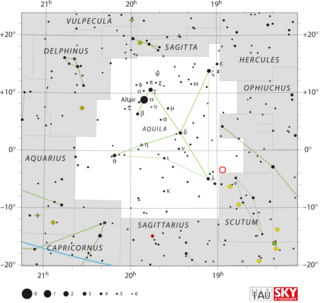
EL Aquilae, also known as Nova Aquilae 1927 was a nova that appeared in 1927. It was discovered by Max Wolf on photographic plates taken at Heidelberg Observatory on 30 and 31 July 1927 when it had a photographic magnitude of 9. Subsequent searches of plates taken at the Harvard College Observatory showed the nova was fainter than magnitude 11.1 on 8 June 1927 and had flared to magnitude 6.4 on 15 June 1927. It declined from peak brightness at an average rate of 0.105 magnitudes per day, making it a fast nova, and ultimately dimmed to about magnitude 21. The 14.5 magnitude change from peak brightness to quiescence was unusually large for a nova.

V1370 Aquilae, also known as Nova Aquilae 1982, is a nova that appeared in the constellation Aquila during 1982. It was discovered by Minoru Honda of Kurashiki, Japan at 20:30 UT on 27 January 1982. At that time the Sun had moved just far enough from Aquila to allow the nova to be seen in the morning sky. Although it was discovered photographically, its apparent magnitude was 6–7, making it potentially visible to the naked eye under ideal conditions. A possible magnitude 20 progenitor was located on the Palomar Sky Survey prints. Spectra of the object were taken in February 1982 at Asiago Astrophysical Observatory, which confirmed that it is a nova.
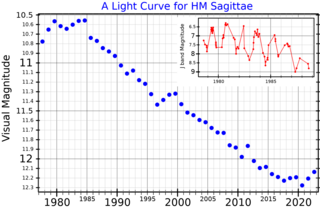
HM Sagittae is a dusty-type symbiotic nova in the northern constellation of Sagitta. It was discovered by O. D. Dokuchaeva and colleagues in 1975 when it increased in brightness by six magnitudes. The object displays an emission line spectrum similar to a planetary nebula and was detected in the radio band in 1977. Unlike a classical nova, the optical brightness of this system did not rapidly decrease with time, although it showed some variation. It displays activity in every band of the electromagnetic spectrum from X-ray to radio.



















